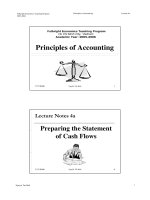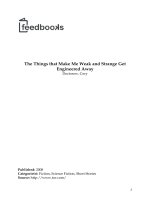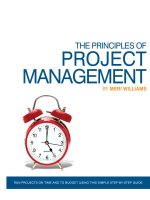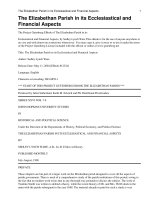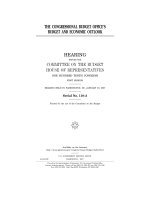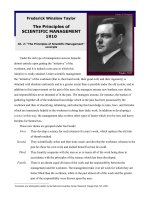Principles of Endowment Management - The seven key issues facing trustees and financial officers pptx
Bạn đang xem bản rút gọn của tài liệu. Xem và tải ngay bản đầy đủ của tài liệu tại đây (484.97 KB, 52 trang )
Principles of Endowment Management
The seven key issues facing trustees and financial officers
TCF-B-6503 EndowPrin PROD 4/2/01 2:55 PM Page 1
PRINCIPLES OF ENDOWMENT MANAGEMENT
A publication of Commonfund Institute
For the Nonprofit Community
Commonfund Institute is dedicated to the advancement
of investment knowledge in the nonprofit community
and the promotion of best financial-management
practices among nonprofit organizations.
The Institute’s programs and services are designed to
serve financial practitioners, fiduciaries, and scholars.
Its programs include seminars and roundtables on
such topics as endowment and treasury management,
proprietary and third-party research, publications, and
special events such as the annual Commonfund Forum
and the Commonfund Prize for the best contribution
to endowment investment research.
The Institute was established by Commonfund in 2000
to serve as the center for its research and education
initiatives with John S. Griswold Jr., Executive
Director and Senior Vice President of Commonfund
Group, as its head.
TCF-B-6503 EndowPrin PROD 4/2/01 2:55 PM Page 2
— JAMES TOBIN, 1981 Nobel laureate, Sterling Professor of Economics, Yale University
The responsibility of managing an
educational endowment differs funda-
mentally from the responsibilities
of most other investment fiduciaries.
The difference arises from the nature
of the beneficiaries.
In most asset management practices,
the beneficiaries, or clients, can
speak for themselves. In the case of
an endowment, however, most of the
beneficiaries have not yet been born.
Future generations of students have as
much entitlement to the benefits of the
endowment as those currently enrolled,
and their rights must be protected.
That differential in time horizon–
between life span and perpetuity–
creates important differences in
management perspective. The dis-
tinction may elude the experienced
investor, because the issues and terms
appear the same in all cases. But for
anyone sharing responsibility for
an endowment, the term “capital
preservation” takes on incomparable
gravity; it means preservation forever.
For that reason, we at Commonfund
have created this publication. In the
following pages we endeavor to set
down a simple perspective on endow-
ment management that all concerned
can share, both the financial profes-
sionals and the admitted amateurs,
both the trustees, who establish policy,
and the officers, who execute it.
After defining basic terms, we focus
on each of seven key issues in endow-
ment management, the issues that
you must take into consideration in
making your decisions.
To simplify our presentation, we will
suggest one essential principle for each
issue. And to enrich the discussion,
we will present a few expert points of
view on a number of these issues.
In a brief brochure, we cannot presume
to provide a thorough education. For
further information and guidance, a
bibliography is included in the back.
We also invite you to take advantage
of the decades of experience accumu-
lated by Commonfund in the course
of advising educational institutions
of many kinds and sizes. Our phone
numbers and addresses are shown on
the back cover for your convenience.
“The trustees of an endowment institution
are the guardians of the future against
the claims of the present. Their task is to
preserve equity among generations.”
TCF-B-6503 EndowPrin PROD 4/2/01 2:55 PM Page 3
3Basics
Beginning at the beginning, this
page tells what an endowment is,
what importance it has for the
institution, and the questions it
raises for trustees and other
policy makers.
- 2 -
Principles
A relatively simple guide to endow-
ment management, summarized
in seven key principles:
4 Principle 1: Objectives
Briefly state the objectives of the
endowment and create a statement
of investment policies.
6 Principle 2: Payout Policy
Decide how much of the endow-
ment to transfer each year to
the operating budget.
10 Principle 3: Asset Allocation
Determine the optimum balance
of the portfolio to achieve the
targeted level of return while
limiting risk.
14 Principle 4: Manager Selection
Select the right investment
specialist for each part of your
diversified portfolio.
18 Principle 5: Risk Management
Systematically search for risks
in every facet of the investment
process.
20 Principle 6: Costs
Keep asking, “Can we get the
same results at lower cost?”
22 Principle 7: Responsibilities
Define the roles of the trustees,
staff, and consultants – in writing.
25 Viewpoints
Comments on specific issues
by several leading practitioners,
each a recognized expert in the
subject discussed.
Our contributors: John Bogle,
Patricia Callan, Charles Collier,
Bennett Fisher, Laurance
Hoagland, William Miller II,
Todd Petzel, William Spitz.
Contents
TCF-B-6503 EndowPrin PROD 4/2/01 2:55 PM Page 2
Basics
The very existence of an endowment
poses a number of difficult questions
that the institution’s policy makers must
continually reconsider.
T
o start, we will define a few basic
terms and describe basic connections.
An endowment can be defined as a
portfolio of assets donated to a non-
profit institution to aid in its support.
In their medieval origins, endowments
consisted of farmland donated to
churches, which would earn rental
income from the land’s tenant farmers.
In modern times, endowment assets
are held in financial instruments,
which may include real estate invest-
ments too. In an invested portfolio,
the modern endowment can realize
capital appreciation as well as current
income.
In the U.S., investment of endowment
funds is generally governed by the
Uniform Management of Institutional
Funds Act (“UMIFA”), first introduced
in 1972 and now enacted in most states.
What benefit does the endowment
bring to the institution? In the short
term, a portion of its annual return
on investment can be transferred to
the school’s operating budget.
Over the long term, an endowment
can provide a financial cushion to
support the institution through
changing times; with this added
stability comes a greater degree of
independence and enhanced ability
to achieve academic goals.
Many institutions can achieve a
competitive difference in the quality
of their programs and students only
because of endowment income.
Institutions may periodically run
capital campaigns to attract new
contributions to their endowments.
Depending on the wishes of the donors,
gifts may include restricted as well as
unrestricted funds, the former limited
to such purposes as faculty compensa-
tion, scholarships, research, athletics,
arts, or expansion of plant.
Inherent in this brief description you
can sense a number of difficult ques-
tions that the trustees, as the policy
makers for the institution, must
continually face, particularly these:
What is the real objective of the
endowment? How should it relate to
the school’s academic mission? How
much should it contribute to the
operating budget? How can endow-
ment value be preserved for the future?
How to invest for maximum return?
How to control the risks inherent
in investing? Who should make the
investment decisions? Who should
assume which responsibilities in
managing the investments?
The following pages offer a way to
approach the answers.
- 3 -
TCF-B-6503 EndowPrin PROD 4/2/01 2:55 PM Page 3
- 4 -
1
PRINCIPLE
Objectives
The Board, in consultation with the
institution’s administration, should determine
the objectives of the endowment and the
policies that will guide its management,
explain them in a written statement,
and periodically review and
update the statement.
TCF-B-6503 EndowPrin PROD 4/2/01 2:55 PM Page 4
- 5 -
Objectives
Members of the governing board
who came of age in the private sector
may tend to think of ultimate objec-
tives in terms of net profit, return on
investment, and shareowner value,
all of which are measurable. In their
institutional roles, however, they have
to cope with more subjective goals.
The terms may resemble those used in
business; profit and growth certainly
have relevance to the management
of an endowment. But in a not-for-
profit environment, success has very
different implications.
It must be understood first in terms
of the social and intellectual utility
of the institution, however intangible
that may seem. And it must be viewed
in a time frame that is incomparably
more extended than those normally
considered in business.
The trustees, in planning endowment
policy, must therefore start with an
understanding of the institution’s
charter and its mission as enunciated
by its president or headmaster and
publicized in its literature. And against
that background they must proceed to
review the condition of the institution
and its needs, short-term and long.
These deliberations are best carried out
in a formal legislative manner, with the
resulting policy expressed in a written
statement. An informal or hurried
approach risks confusion, misunder-
standing, second guessing, and delay.
The members of the Board, after all,
represent various backgrounds, points
of view, and priorities. As in any
such deliberative body, conclusions
inevitably depend on compromise.
The written statement brings the
tensions of the varied perspectives
to a resolution, opening the way for
action – at least until the next round.
The Board’s policy statement sets the
course for endowment management.
Before assets are allocated or invest-
ments selected, the trustees, through
their policy making, will have made
the most significant contribution to
the achievement of their objectives.
Here, then, are the key issues that
the policy statement should resolve:
◆
The role of the endowment in
supporting the institution’s mission
◆
The role of the endowment in
maintaining a healthy balance sheet
◆
How much of the endowment’s
return should be spent, and how
much reinvested
◆
How much of expendable gifts should
be channeled to the endowment as
opposed to current spending
◆
The extent to which the operating
budget should be supported by the
endowment
◆
Overall investment strategy, partic-
ularly asset allocation
◆
Who should have responsibility for
investment decisions
◆
Which investment decisions, if
any, should be delegated to outside
consultants, advisors, or investment
managers.
TCF-B-6503 EndowPrin PROD 4/2/01 2:55 PM Page 5
- 6 -
2
PRINCIPLE
Payout Policy
In deciding the
amount to be
transferred from
the endowment to
the operating budget each year, the Board,
working with the administration, must
carefully balance two opposing claims:
the current needs of the institution and its
constituencies vs. the obligation to preserve
the endowment for future generations.
TCF-B-6503 EndowPrin PROD 4/2/01 2:55 PM Page 6
- 7 -
Payout Polic y
And so, recognizing the primary
purpose of the endowment– to augment
the year’s operating budget– you turn
to that most challenging question:
How much can the endowment afford
to contribute?
In times gone by, this question could
be answered by another question:
How much is needed? Or another:
How much did the endowment earn?
But in modern times, the issue has
become more complicated.
Perceived need provides questionable
guidance. For instance, an accumula-
tion of favorite programs and causes
could induce excessive withdrawal
from the endowment, reducing its
value for the future.
While making your spending decision,
you certainly must concern yourself
about the health of your institution’s
balance sheet. Should you direct any of
this year’s spending to debt reduction?
On the other hand, gifts could enlarge
the endowment’s capital, increasing
the potential dollar return of future
investing. What results can you expect
from pending fundraising campaigns?
A few institutions commit themselves
to transfer a steadily increasing
amount to their budgets year over
year. The annual increases are intended
to compensate for inflation, or for
the growth of total expense. This
approach, however, risks a sharp
decline in endowment value in the
event of a sharp market decline, a
trauma from which it could take
a long time to recover.
The endowment’s income, defined as
dividends and interest, also falls short
as a spending criterion, because for
quite some time income-oriented
investments have failed to keep pace
with economic growth.
If you invest the endowment primarily
to maximize income, you risk eroding
its capital value in the not very long
term. If, on the other hand, still using
income yield as your spending guide,
you nevertheless invest only part of
the portfolio for income, you risk
depriving the operating budget of
added funds it really could use and
should have.
Since the introduction of the Uniform
Management of Institutional Funds
Act (“UMIFA”) in 1972, endowment
decision makers have generally been
subject to the so-called “prudent
investor rule,” which permits them
to consider the expected total return
(i.e., capital appreciation as well as
income) of the institution’s investments.
They could then calculate the payout
rate as a percentage of the endowment’s
total net asset value. Most colleges
and universities now use that approach.
TCF-B-6503 EndowPrin PROD 4/2/01 2:55 PM Page 7
- 8 -
On the question of payout rates, it
has been demonstrated that less ulti-
mately becomes more. Comparing
spending rates of 4%-7%, for instance,
it’s been demonstrated that, after
about 20 years, the lower rate, having
allowed greater capital accumulation
in the endowment, will result in a
higher absolute dollar level of payout,
paradoxical as that may seem.
Many schools, colleges and univer-
sities establish a payout formula that
they commit to maintain unchanged
On the other side of the ledger, you
find endowments contributing around
10% of the annual operating budget.
Like most averages, these figures leave
a lot of variables to worry about. Such
as inflation. Whether it’s currently
running at a high rate or low, inflation
will inevitably erode some of your total
return. And the cost of managing
the endowment will consume another
small piece. What’s left– the real
return – may or may not prove ade-
quate to match the growth of your
institution’s budget.
The UMIFA, of course, does not
specify what the payout percentage
should be; the school’s governing Board
still bears the burden of that decision.
Certain rules of thumb, however,
have become apparent from surveys
of general practice.
Withdrawals from endowments, on
average, have tended to converge at
5.5% of the net asset value of the
endowment. Institutions with smaller
endowments tend to take a somewhat
higher percentage. Those with the
largest endowments take a much
smaller percentage.
Source: Cambridge Associates
‘89 ‘92 ‘95 ‘98‘86‘83‘80‘77‘74‘71‘68
Calendar Years
0
1
2
3
4
5
6
7
Dollars
Effect of Various Payout Rates Over 30-year Period
The higher the rate of spending, the lower the real dollar spending after 20 years.
● Spend
7% ● Spend 6%
● Spend 5%
● Spend 4%
TCF-B-6503 EndowPrin PROD 4/2/01 2:55 PM Page 8
- 9 -
Payout Polic y
side – the return on the endowment’s
investments. The condition of the
markets will, of course, impact invest-
ment results. But no one can predict
market changes reliably, and attempts
to time the market ultimately fail.
In the long run, it is the way you
balance the assets in your portfolio
that will have the greatest effect on
investment results. And that takes us
to our third principle of endowment
management– asset allocation.
In endowment management, as in
business, you often have to run faster
just to stay abreast. The needs of the
institution inexorably keep growing –
now and in the future. But even as the
pressure mounts to spend more this
year, it becomes imperative to save
more, to help grow the endowment at
least as fast as inflation, to strengthen
its ability to fund the greater needs
of future generations.
While confronting these pressures on
the spending side, the decision maker
must also pay attention to the inflow
year after year. But others prefer to
re-examine the question each year
and reset their spending at a rate that
responds to current conditions.
To smooth out the effects of year-by-
year variations, some institutions base
their calculations on a moving average
rather than just the last year. For
instance, they might set the spending
rate as a percentage of the average
value of the portfolio over the past
five years.
TCF-B-6503 EndowPrin PROD 4/2/01 2:55 PM Page 9
- 10 -
3
PRINCIPLE
Asset Allocation
In seeking the return you
need to support your payout
policy – at an acceptable level
of investment risk– you start
with your most crucial decision,
the balance of the endowment portfolio
among the asset classes, a decision that the
Investment Committee should review each
year and maintain through rebalancing at
least annually.
TCF-B-6503 EndowPrin PROD 4/2/01 2:55 PM Page 10
- 11 -
Asset Allocation
Historically, the legal responsibility
that trustees bore for endowment
management fostered a highly con-
servative investment bias. By court
ruling, common stock was deemed
“per se imprudent.” The experience of
the 1930s, however, proved that bonds
could be risky, too. The century-old
legal principle, “the prudent man rule,”
then became the pervasive guide for
trustees, giving them greater discretion
in selecting investments.
The introduction of UMIFA in 1972,
discussed earlier in this publication,
broadened the “prudent man rule” into
a “prudent investor rule” that permitted
endowment fiduciaries to take into
account many of the new developments
that have changed the landscape of
the investment world during the past
half century.
These changes include new financial
management technologies and new or
improved products, such as options
and futures, venture capital, private
placement, easy access to international
markets, mutual funds, and various
real estate vehicles. Another relevant
development was the rise of a new
generation of investment management
professionals, and another was the
advent of new theoretical thinking
about portfolio management.
The new thinking, under the heading
“modern portfolio theory,” involves
much complex work by a number of
Nobel laureates in economics. The
aim was a better understanding of
the relationship between investment
risk and return. A simplified summary
of these complex ideas might go as
follows:
The degree of risk entailed in a
particular investment can be expressed
as its volatility, which can be calibrated
statistically. This statistic, called a
“standard deviation,” indicates in per-
centage terms the degree to which an
investment has varied in the course of
arriving at its mean return over a given
time period. In general, investments
with the greatest volatility – with the
highest standard deviation – have been
shown to produce the greatest gains
over the long term. To get the most out
of your investments, you must therefore
include some that have a relatively
high degree of risk. But you can offset
their volatility by including other types
of investments that perform differently,
whose performance has a low degree
of correlation.
Correlations Among Asset Classes and Inflation
Perfect correlation is indicated by 1.00. Lower numbers indicate a lower degree of correlation.
Negative numbers indicate reverse correlation– when one class goes up, the other goes down.
SP500 SmCap PrivCap IntEq RealEst Tr-1 Tr-5 Tr-20 HiGrC HiYdC IntBnd Infln
S&P 500 1.00
US Small Cap 0.70 1.00
Private Cap 0.40 0.26 1.00
Intl. Equity 0.46 0.33 0.18 1.00
Real Estate 0.18 0.12 0.11 0.11 1.00
1yr US Treasy -0.09 -0.09 0.06 -0.02 0.38 1.00
5yr US Treasy 0.32 0.22 0.13 0.13 -0.08 -0.06 1.00
20yr US Treasy 0.43 0.31 0.16 0.18 -0.15 -0.29 0.90 1.00
HiGrade Corp 0.42 0.30 0.15 0.18 -0.15 -0.29 0.88 0.97 1.00
HiYield Corp 0.36 0.25 0.13 0.16 -0.13 -0.24 -0.76 0.84 0.89 1.00
Intl. Bonds 0.15 0.10 0.05 0.56 -0.03 -0.04 0.41 0.37 0.36 0.31 1.00
Inflation -0.31 -0.25 -0.05 -0.13 0.24 0.75 0.02 -0.15 -0.14 -0.11 -0.01 1.00
Source: Commonfund’s Endowment Planning Model
TCF-B-6503 EndowPrin PROD 4/2/01 2:55 PM Page 11
- 12 -
The new thinking shifted the main
focus of investors from the selection of
securities to the design of their overall
portfolio. More important than picking
the right stocks was found to be the
proportion of equity to fixed income
to cash. In fact, the allocation of the
portfolio among the asset classes proved
to be the most important determinant
of investment success.
Increasing diversification within asset
classes can help reduce volatility still
further. A balanced portfolio may
include small-capitalization stocks as
well as large-cap stocks, international
stocks as well as domestic stocks, cor-
porate bonds as well as governments,
long- and intermediate-term as well
as short-term fixed-income.
A huge accumulation of data on invest-
ment performance and the development
of sophisticated software have made
it convenient to forecast how different
asset allocations are likely to perform
long term and the degree of volatility
they are likely to experience. These
computations can take into account the
way the volatility of one type of asset
may diminish or cancel the effect that
the volatility of another will have. They
can also quickly show you the effect
of your payout rate on net portfolio
value over time.
Asset allocation software can prove
not only useful but also intriguing. As
you input changes to your asset mix,
the data on the screen quickly show
you the resulting changes in projected
return and standard deviation.
These models are particularly useful
in giving relative behaviors of different
asset mixes. But they should not be
relied on to forecast specific returns
or volatilities; the future may differ
significantly from historical experience
reflected in the models.
Though enormously helpful, the
computer cannot, of course, make
this important decision for you.
Asset allocation is the cornerstone of
your endowment’s investment policy
and a key responsibility of the govern-
ing Board. Your strategic asset alloca-
tion policy should set the course for
endowment investing for many years to
come. It involves more than numbers.
Endowment Asset Mix
Endowment Size
Over $1 $501-1,000 $251-500 $100-250
Type of Investment Billion Million Million Million
Active common stocks 33.2% 36.6% 47.2% 49.5%
Passive common stocks 7.5 9.6 5.6 7.0
Total domestic stocks 40.7% 46.2% 52.8% 56.5%
Active international stocks 10.9% 12.0% 9.1% 9.6%
Passive international stocks 1.1 1.8 1.8 1.7
International bonds 1.9 1.6 0.8 0.5
Total international 13.9% 15.4% 11.7% 11.8%
Active bonds 22.8% 17.7% 16.2% 17.3%
Passive bonds 1.0 3.5 3.6 1.8
Total domestic bonds 23.8% 21.3% 19.8% 19.1%
Equity real estate 3.7% 2.0% 1.7% 1.8%
Real estate mortgages 0.1 0.2 0.4 0.4
Private equity 11.6 7.5 8.2 4.6
Short-term securities/cash 2.5 2.0 2.6 2.3
Other 3.7 5.5 2.8 3.5
Total 100.0% 100.0% 100.0% 100.0%
Note: Dollar weighted and projected to the Greenwich Associates universe
Source: Greenwich Associates–IMF 2000
TCF-B-6503 EndowPrin PROD 4/2/01 2:55 PM Page 12
- 13 -
Asset Allocation
The planning and decision process
is best carried out in a systematic,
disciplined manner. Indeed, the
Investment Committee should agree on
the planning agenda first, making sure
it gives each trustee the opportunity to
express his or her vision and concerns.
What are the expectations of each
trustee for total return? What time
horizons or milestones does each one
see in the period ahead? Let each one
describe the level of risk or volatility
he or she considers tolerable.
What types of assets or investment
vehicles should the portfolio include?
The trustees must discuss the pros and
cons of each and decide on a list of
candidates. The discussion can help
promote better understanding between
the investment professionals on the
Board and the rest of the trustees.
The decisions of the Investment Com-
mittee should be written down in a
formal policy statement that should
include the Committee’s rationale for
each of its decisions. The clarity of the
statement can make a vital difference
in the months and years ahead. It
becomes the guide for implementation
of the investment strategy.
And it maintains continuity as times
change and the membership of the
Committee changes.
To implement the asset allocation
policy, the Committee employs profes-
sional investment managers, which
is the subject of the next principle.
The Committee, in exercising its
responsibility, maintains oversight.
Inevitably, the de facto asset allocation
will stray from policy as the movements
of the various markets take effect. The
theory behind asset allocation strategy
prescribes periodic rebalancing to
bring the allocation back to the
proportions that were chosen in estab-
lishing policy. This means selling
appreciated assets and reinvesting
the proceeds in cheaper ones.
Rebalancing has its difficulties, espe-
cially in volatile markets. For some, it
may prove emotionally difficult to sell
winners to buy losers. But, looked at
another way, this is forcing participa-
tion in the very essence of successful
investing – to buy cheap and sell dear.
Rebalancing requires a discipline,
which ought to be defined in the
policy statement. In future years,
trustees may too quickly become
nervous about market behavior.
Rebalancing, if carried out too often
can raise the cost of investing, or if
done irregularly can vitiate the benefits
of your asset allocation strategy.
TCF-B-6503 EndowPrin PROD 4/2/01 2:55 PM Page 13
- 14 -
4
PRINCIPLE
Manager Selection
Investment managers must be studied
in depth, not just for past performance,
and selected to effect a diversification
that will optimize return
while limiting overall
portfolio risk.
TCF-B-6503 EndowPrin PROD 4/2/01 2:55 PM Page 14
- 15 -
Manager Selection
The new thinking in this era of mod-
ern portfolio theory has made diversi-
fication the first commandment of
investment prudence. In essence it is
only common sense, as in the ancient
aphorism, “Never put all your eggs in
one basket.” In its fullest realization,
diversification applies not only to the
contents of the portfolio but also to its
management.
As obvious as this idea may seem,
it was not always observed. In the
past, trustees often did the investing
themselves, or they assigned the entire
endowment to one or two all-purpose
managers. Large endowments may
have their own staff of investment
managers in house, which they might
supplement with outside firms to
manage specific parts of the portfolio.
In general, endowments now tend to
split their portfolios among a variety
of specialized investment managers
with demonstrable talent for exceeding
their benchmarks. Obviously, the
selection and oversight of a varied
roster of investment managers
requires organization.
The institution’s business or financial
staff handles most of the work, but the
Investment Committee retains respon-
sibility. It can initiate the process on
a rational note by analyzing its asset
allocation policy and identifying the
segments of the portfolio to be assigned.
First the asset classes are selected
(e.g., stocks, bonds, cash), then specific
styles and subsets are chosen within
each class (e.g., growth, value, large
cap, small cap). Taking this a step
further, the Investment Committee
could specify the qualifications it will
require of the managers in each segment.
The responsibility for selecting,
monitoring, and balancing investment
managers can weigh more heavily on
the Investment Committee and business
staff than they consider comfortable.
The processes involved are not only
specialized but quite sensitive: if you
manage it all yourself, how do you
explain results that miss your objectives?
For that reason, many educational
institutions decide to outsource this
function. It is essentially the same
decision that increasing numbers of
business enterprises have been making:
to concentrate on their core compe-
tencies and outsource the rest of the
work to specialized services.
In the interest of full disclosure,
we must point out that managing
investment managers constitutes the
chief occupation of Commonfund.
We manage managers for many
hundreds of educational institutions
and other nonprofits. The following
discussion summarizes what we
believe to be the basic principles of
selecting investment managers and
is not intended to promote our own
capabilities.
TCF-B-6503 EndowPrin PROD 4/2/01 2:55 PM Page 15
- 16 -
Selecting investment specialists
has itself become a specialized skill,
because there are thousands to choose
from, and the well-known stars do
not always represent the best choice.
Candidates must be investigated in
depth. Performance data alone can
prove misleading, especially if they
cover only a short term – less than
five years. Performance in less than
one market cycle could tell more about
the firm’s luck than skill. And past
performance alone has never provided
a reliable prediction of future success.
In each segment or specialization,
the manager-selection process must
include several necessary steps:
◆
Compiling a list of candidates
◆
Gathering basic information about
them
◆
Narrowing the list
◆
Conducting preliminary due diligence
◆
Selecting the finalists
◆
Completing due diligence
◆
Hearing presentations of the finalists
◆
Making final selection
◆
Conducting negotiations
Starting with your first list of candi-
dates for a particular segment of the
portfolio, what do you need to know?
A lot. What is the firm’s investment
style? Its philosophy? What evidence
is there of its commitment to that
philosophy? How does the firm’s
decision making process work? What
kinds of internal controls does it use?
What about its reporting system, its
quality and timeliness?
Considering its investment approach,
how will it complement the other
investment managers in your roster?
What is the firm’s ownership struc-
ture? What is the quality of its senior
management? What are the qualifica-
tions of its professionals? How stable
has been its professional staff ?
How large is the firm in terms of
assets under management? How has it
grown? How has it changed? Is it too
large? What are its fees?
And, finally, does the firm have
any connection to any member of
the Board? And, further, what is the
Board’s position with respect to
conflict of interest?
TCF-B-6503 EndowPrin PROD 4/2/01 2:55 PM Page 16
- 17 -
Manager Selection
Completion of the selection does not
end the process. Regular monitoring
must include not only performance
review against relevant benchmarks
but also vigilance for any fundamental
changes in the firm, which may be
reason to start the selection process
for that segment all over again.
A key resource of the manager of
managers is its base of information
on the expanding world of investment
managers. The information collected
about any one manager under consid-
eration will cover every aspect of
that manager’s business.
The breadth and accuracy of the col-
lected information is, of course, crucial.
In our manager-information template,
the questions alone take up 23 pages.
The professional staff of the manager
of managers sifts and sorts this infor-
mation to help its client institutions
optimize portfolio building. By experi-
ence and education, these professionals
must be capable of making the same
kinds of investment decisions as the
managers themselves have to make,
because the manager of managers
must evaluate performance and every-
thing else about the chosen managers
before any shortcomings become
significant.
To facilitate portfolio building, the
manager of managers packages groups
of managers into asset-type-specific
funds. For instance, a small-cap value
fund, or an international bond fund,
or a real estate fund. It will offer a
variety of funds, of varying breadth
and specificity.
Generally, the more funds it offers,
the more useful it can be to its clients.
It may package offerings that represent
a single strategy, or even a single man-
ager, using its group buying power to
make particular investment managers
more readily available to more investors.
It can offer funds in all asset categories
including private capital, hedge funds
and other alternative investments.
The manager of managers works with
the trustees’ Investment Committee
and its consultants on the make-up
and care of the endowment’s portfolio,
advising them on the selections from
its array of funds that, in combination,
best serve the endowment’s objectives.
On this foundation of capabilities,
the manager of managers structures
related supports and services that can
strengthen the institution’s investment
experience; the firm can provide
integrated reporting and analysis,
investment education, risk manage-
ment, and legal oversight.
At its best, the manager of managers
operates as a skilled partner of the
Investment Committee and business
staff in the management of the insti-
tution’s endowment.
TCF-B-6503 EndowPrin PROD 4/2/01 2:55 PM Page 17
- 18 -
5
PRINCIPLE
Risk Management
Think of risk as the possibility of failing to
meet the Board’s objectives, and make sure
every facet of your endowment management
system, internal and external, has built-in
disciplines to recognize
the risks and promptly
neutralize them.
TCF-B-6503 EndowPrin PROD 4/2/01 2:55 PM Page 18
- 19 -
Risk Management
If you look it up, you find risk defined
as the possibility of loss. In investment
management, it is generally stated
in terms of price volatility. But these
definitions fall short in the endow-
ment world with its super-long-term
outlook and seemingly impersonal
consequences.
In endowment management, we
should define risk as the possibility of
failing to meet objectives –any of the
objectives agreed upon by the Board
and Investment Committee.
Your attention is likely to turn first
to the risk of suffering a major loss,
the risk of falling short of your total-
return target, the risk of not earning
sufficient income to transfer to the
operating budget.
But the risks do not stop there. Failures
can occur in any part of the endow-
ment management process, internal
or external – in operations, in the safe-
keeping and accounting of assets, in
legal or regulatory issues, in outright
fraud. Any such failure could reverber-
ate through succeeding generations.
The challenge becomes even more
complicated when you mix in the
expectations of the various principal
players. Whereas objectives are agreed
upon and written down in advance,
expectations are subjective, varied, and
sometimes not revealed until they’ve
turned into disappointments.
Your investment target might be stated
as a total return of 8% per annum,
but meanwhile, in an atmosphere of
irrational exuberance, expectations
could be pushing 25% – and then
you begin making decisions as if 20%
was indeed your objective. Unrealistic
expectations can distort objectives
and undermine strategies.
The response to this challenge – risk
management– should not be looked
at as a specific function but rather as
a discipline that must pervade every
facet of endowment management.
You weave it into every job description,
internal and external.
The trustees cannot implement such
practices themselves, but they can raise
awareness of the issue. They start by
becoming sensitive to the “galaxy of
risks” that their decisions and expecta-
tions might entail.
It’s a matter of taking a skeptical
attitude and asking difficult questions.
Such as: Is our portfolio strategy truly
consistent with our stated objectives?
Is each segment of the portfolio ful-
filling the role assigned to it? In whose
name are the assets in our portfolio
being held? Where are they held?
Is the valuation accurate? Are we apply-
ing the resources actually needed to
manage effectively? Or should we
outsource? What are the laws and
regulations with which we need to be
in compliance? Who is responsible
for compliance? Do our investment
managers and other outside providers
have the compliance capability they
need? What makes us sure we can
trust them?
The specific questions will vary with
the situation, but asking uncomfortable
questions should be considered essen-
tial. If the Board or staff does not seem
to have the wherewithal for an inte-
grated risk management program,
you may need consultative support
to get you started.
TCF-B-6503 EndowPrin PROD 4/2/01 2:55 PM Page 19
- 20 -
6
PRINCIPLE
Costs
The costs of your investment program can
quietly undercut returns; make sure you
keep those costs down. Keep asking,
“Can we get the same results
at lower cost?”
TCF-B-6503 EndowPrin PROD 4/2/01 2:55 PM Page 20
- 21 -
Costs
All too often an Investment Com-
mittee discovers that its investment
costs have soared. What happened?
Frequently, the Committee has failed
to exercise any cost controls worth
mentioning.
The investment management
function requires a deliberate
commitment to cost management.
Cost control essentially involves
three types of activity: One, diligent
investigation of alternative candidates.
Two, tough negotiation of fees.
Three, efficient management of the
firms managing investments for you.
Cost management also means avoiding
needless transactions, because every
trading decision has a cost.
And keep in mind that cost reduction
itself can have its costs. You don’t want
to compromise the effectiveness of
your risk management for the sake of
cutting cost. Keep the balance.
TCF-B-6503 EndowPrin PROD 4/2/01 2:55 PM Page 21
- 22 -
7
PRINCIPLE
Responsibilities
To promote harmonious
effectiveness of your
investment program,
define the roles of the trustees, the business
or investment officer and staff, and your
consultants, in writing, and make sure each
understands and agrees.
TCF-B-6503 EndowPrin PROD 4/2/01 2:55 PM Page 22
- 23 -
Responsibilities
The Board defines the responsibilities
of all major participants in the endow-
ment management process, starting
with its own.
As stated on the first page of this
document, the Board’s most basic
responsibility is to preserve the
endowment in perpetuity. That, of
course, refers not to current valuation
numbers but to its real value, in
terms of purchasing power.
The Board must ensure that future
students will be able to obtain the same
level of benefits from the endowment
as current students do, not counting
the effect of gifts. Which means the
endowment must currently earn a
total return at least equal to the spend-
ing rate, plus inflation, plus the cost of
managing the endowment’s funds.
In exercising their responsibilities, the
trustees perform a policy making role.
They assign the tasks required for
implementation to staff and outside
experts. But still, the buck stops with
the Board.
Upholding the Board’s basic responsi-
bility can prove daunting. The institu-
tion’s constituencies are not likely to
show much enthusiasm for preserving
endowment assets for future genera-
tions. Their own needs are clear,
present and possibly urgent. The
needs of future generations are not even
vague, they are invisible. Perpetuity
seems too far away to count.
The Board may create an Investment
Committee to exercise responsibility
for spending and investment policies.
The Committee is likely to attract those
trustees who have relevant experience,
who can bring a measure of expertise
to these issues and a sharper focus.
The Board should take care that it
achieves a balance in the composition
of the Committee; its membership
ideally will include trustees with various
backgrounds in business and finance
and also, if available, in education or
other nonprofit institutions. But com-
mittee members must beware of getting
too close to home; they must avoid
conflicts of interest or even the impres-
sion that they might exist.
Aside from its policy setting role, the
Investment Committee educates the
rest of the Board on all endowment
management issues and the reasons
behind its policy decisions. The
Committee also serves as the Board’s
liaison with the institution’s Finance
Committee and business staff.
The institution’s business manager,
or investment officer, leads the
business staff in implementing the
Investment Committee’s policies
and decisions.
TCF-B-6503 EndowPrin PROD 4/2/01 2:55 PM Page 23
